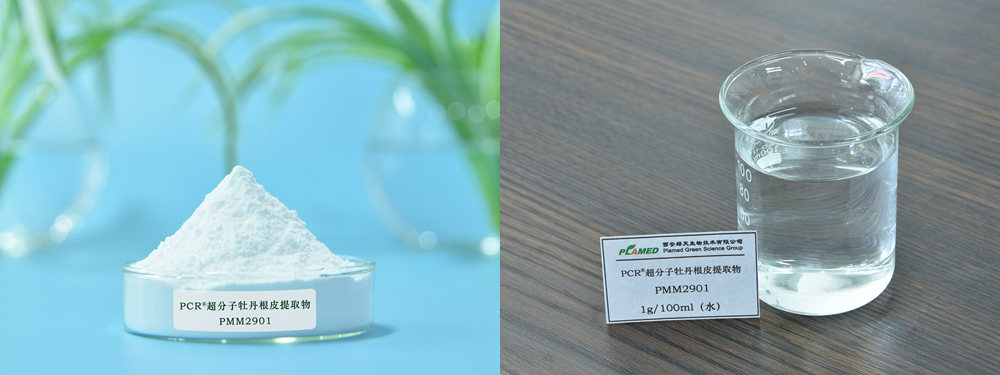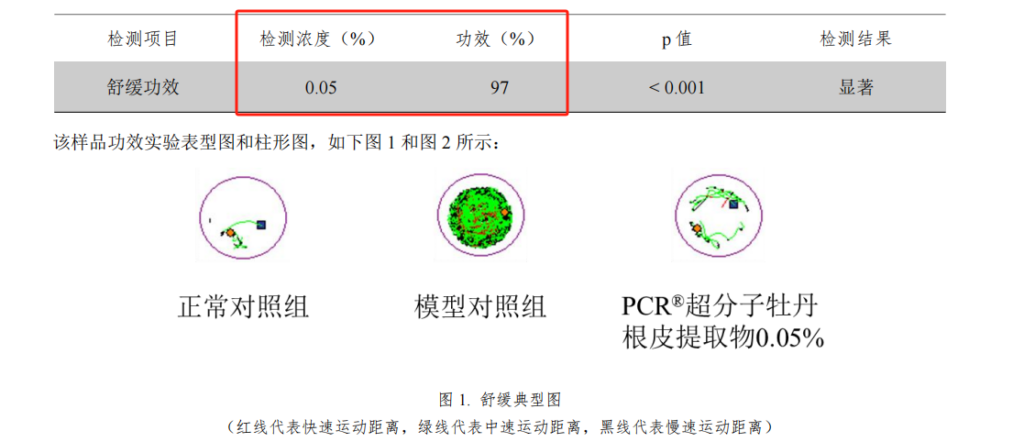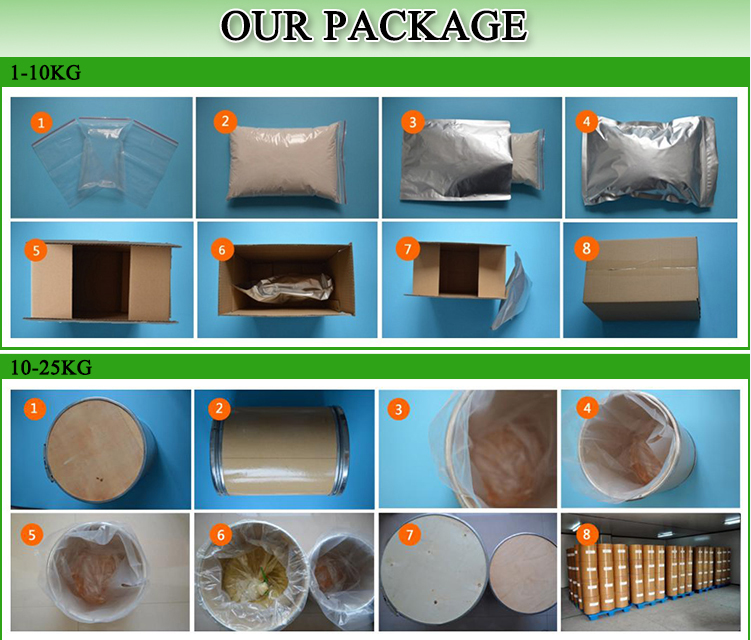1. PCR® Supermolecule Paeonia Suffruticosa Root Extract Overview
Paeonia Suffruticosa Root Extract, derived from the root cortex of peony, a traditional Chinese medicinal herb, is rich in chemical constituents, including a variety of phenols (e.g., paeonol) and monoterpenes, etc.
Paeonol has a variety of pharmacological effects, including anti-inflammatory, anti-allergic, antibacterial and analgesic. It can be used to treat itching, redness and swelling of the skin caused by eczema, dermatitis and other diseases. In addition, paeonol is also useful in relieving discomfort caused by bacterial infections and inflammation.
After Plamed’s research and testing, we found that Paeonia Suffruticosa Root Extract has a significant inhibitory effect on inflammatory factors and mediators, so we have positioned PCR® Supermolecule Paeonia Suffruticosa Root Extract as a water-soluble anti-inflammatory botanical. We therefore characterize PCR® Supermolecule Paeonia Suffruticosa Root Extract as a water-soluble anti-inflammatory botanical factor, suitable for use in a wide range of anti-inflammation products.
| Product name | PCR® Supermolecule Paeonia Suffruticosa Root Extract |
| INCI name | PAEONIA SUFFRUTICOSA ROOT BARK EXTRACT, HYDROXYPROPYL CYCLODEXTRIN |
| Active substance | Paeonol≥4.5% |
| Soluble in | Water |
| Recommend dosage | ≤2.2% |
| Product highlights★ | water-soluble anti-inflammatory
botanical factor |

2. Paeonia Suffruticosa Root Extract Mechanism
- Anti-inflammatory
Paeonol can down-regulate the activation of nuclear transcription factor NF-κB (inflammatory signaling pathway) and inhibit its expression in the nucleus, thus inhibiting the expression of IL-1β, IL-6, TNF-α and PGE2. At the same time, Paeonol can inhibit the further expression of iNOS to stop the production of the inflammatory factor NO, thus achieving the anti-inflammatory effect [1].

- Anti-aging
Human skin is stimulated by external (ultraviolet, ultrasound, radiation, etc.) stimulation, the mitochondria will produce an excessive amount of oxygen free radicals (ROS), and excessive oxygen free radicals will cause an increase in the activity of elastase, so that the skin loses its elasticity; excessive oxygen free radicals will also promote the release of inflammatory factors and cause inflammation; excessive oxygen free radicals will also enhance the expression of protein hydrolases (MMP1,2,3,9,10), specific degradation of extracellular matrix components, damage to the normal structure of collagen fibers1 and elastin fibers, leading to wrinkles and other aging manifestations of the skin. Paeonol can directly react with oxygen free radicals and consume the excess oxygen free radicals in the body; at the same time, Paeonol can enhance the activity of antioxidant enzymes to rapidly eliminate oxygen free radicals. Thus, it can achieve the purpose of anti-oxidation and anti-aging.

- Whitening
Melanin is the enzyme tyrosinase that catalyzes the conversion of tyrosine to L-dopa, which then produces L-dopaquinone, resulting in melanin. paeonol inhibits tyrosinase activity, thereby inhibiting the production of melanin. Excessive production of melanin in the skin may lead to hyperpigmentation, resulting in dark skin and spots. Therefore, Paeonol can be used in cosmetics to whiten skin and remove spots.

3. Technical Data Sheet
| ANALYSIS | SPECIFICATION |
| Paeonol | ≥4.5% HPLC |
| Organoleptic | |
| Appearance | Powder |
| Color | White to off-white |
| Odor | Characteristic |
| Physical Characteristics | |
| Moisture | ≤10.0% |
| Ash | ≤7.0% |
| Heavy Metal | |
| Pb | ≤10ppm |
| As | ≤2ppm |
| Hg | ≤1ppm |
| Cd | ≤5ppm |
| Microbiological Test | |
| Total plate count | ≤1000CFU/g |
| Yeast & mould | ≤100CFU/g |
| Pseudomonas aeruginosa | Not detected |
| Staphylococcus aureus | Not detected |
| E.coli | Not detected |
4. Paeonia Suffruticosa Root Extract Benefits
- Anti-inflammation
Phenols in Paeonia Suffruticosa Root Extract have the effect of inhibiting the release of inflammatory mediators and cytokine expression, which can reduce the local immune response and the level of oxidative stress, thus reducing the symptoms of inflammation such as redness, swelling and heat sensation.
- Anti-aging
Paeonia Suffruticosa Root Extract contains antioxidants that scavenge free radicals and slow down skin aging. In addition, it has an inhibitory effect on metalloproteinases and elastases, and an activating effect on tissue proteases, which helps to revitalize the skin and slow down the aging process.
- Whitening
Anthocyanins in Paeonia Suffruticosa Root Extract can inhibit the synthesis of melanin and reduce the precipitation of melanin, so as to realize the effect of lightening pigmentation and improving skin tone.
5. PCR® Supermolecule Paeonia Suffruticosa Root Extract Efficacy Tests
- Anti-inflammation
Paeonol significantly inhibits the production of TNF-α (Tumor Necrosis Factor α) in BV-2 and RAW264.7 cells with anti-inflammatory efficacy [2].

Paeonol significantly inhibits the production of IL-1β in BV-2 and RAW264.7 cells with anti-inflammatory efficacy [2].

Paeonol significantly inhibits the production of IL-6 in BV-2 and RAW264.7 cells with anti-inflammatory efficacy [2].

PCR® Supermolecule Paeonia Suffruticosa Root Extract inhibited the content of pro-inflammatory factors (IL-1β, IL-6, TNF-α) and inflammatory mediators (PGE2) by 72.06%, 79.84%, 54.54% and 91.14%, respectively, at a concentration of 0.25%.

Based on zebrafish testing, PCR® Supermolecule Paeonia Suffruticosa Root Extract has 97% neurological soothing efficacy at a concentration of 0.05%.

Based on zebrafish anti-inflammation testing, PCR® Supermolecule Paeonia Suffruticosa Root Extract has been shown to have 83% soothing effect on inflammation at a concentration of 0.05%.

- Anti-aging -Oxygen radical scavenging
From the figure, it can be seen that Paeonol has a significant scavenging effect on oxygen free radicals, and the strongest effect of Paeonol was found at a concentration of 20µM, which in turn indicates the anti-aging effect of Paeonol [3].

- Whitening
From the figure, it can be seen that the inhibitory effect of Paeonol on tyrosinase activity increases with increasing concentration of Paeonol, and the effect on the amount of melanin synthesis also increases with increasing concentration, thus confirming that Paeonol can achieve a reduction in melanin production by inhibiting tyrosinase activity [4].

As shown in the figure, compared with the blank control, the pigmentation of Paeonol-treated skin at the treated site was significantly suppressed, and the skin became significantly whiter. Thus, the topical application of Paeonol to the skin was confirmed to have whitening efficacy [5].


The upper figture shows the effect of natural products (two-week treatment) on pigmentation stimulated by two weeks of UVB irradiation of guinea pig skin. (A) Appearance of guinea pig skin; (B) Microscopic appearance of pigmented epidermis; (C) Microscopic appearance of dermal pigmentation; (D) HE staining images of stained skin sections (E) Fontana-Masson staining images of stained skin sections. I: Blank control; II: Paeonol treatment group
6. PCR® Supermolecule Paeonia Suffruticosa Root Extract Advantages
- Light color
PCR® Supermolecule Paeonia Suffruticosa Root Extract uses Supermolecule Capture Technology + Decolorization Technology to solve the problem of the dark color of Paeonia Suffruticosa Root Extract, so that its properties are white to off-white powder.
- Water soluble
Plamed solved the problem of insolubility of the active substance Paeonol in Paeonia Suffruticosa Root Extract by utilizing an original supramolecular capture technology to make it soluble in water.
- High stable
The PCR® Supermolecule Paeonia Suffruticosa Root Extract solutions with different PH (PH<9) were transparent and colorless after 1 year at low (4℃), normal (20~30℃) and high (45℃) temperatures without obvious discoloration.

- Technology
Plamed develops PMRelief® 9292 by supramolecular capture technology. The technology creatively integrates supramolecular embedding technology and molecular membrane filtration technology. It not only protects the active substance from acid, alkali, high temperature, sunlight and extraction chemical solvents. Also it greatly ensures the naturalness and safety of the active substance. What’s more, it improves the bioavailability of the active substance and prolongs the duration of action.


7. PCR® Supermolecule Paeonia Suffruticosa Root Extract Application
In the past year, Paeonia Suffruticosa Root Extract’s number of filings and social media voice have increased year-on-year, with filings growing by more than 64%. This indicates that consumers are gradually recognizing the efficacy of Paeonia Suffruticosa Root Extract in skin care products.
8. PCR® Supermolecule Paeonia Suffruticosa Root Extract Safety
- Human skin patch test
The safety test of 1.5% PCR® Supermolecule Paeonia Suffruticosa Root Extract was conducted according to the Technical Code for Cosmetic Safety (2015 edition), and the results showed that none of the 30 people had any adverse skin reactions 48h after using the sample.

9. Packing and Storage
Package: Packed in 25kg paper drums with two plastic bags inside.
Storage: Stored in a cool and dry place and away from direct sunlight and oxidizing agents.

10. Reference
[1] Fujing W ,Maomao Z ,Nan J , et al. Paeonol ameliorates lipopolysaccharides-induced acute lung injury by regulating TLR4/MyD88/ NF-κB signaling pathway. [J]. Die Pharmazie, 2019, 74(2): 101-106.
[2] Himaya S ,Ryu B ,Qian Z , et al. Paeonol from Hippocampus kuda Bleeler suppressed the neuro-inflammatory responses in vitro via NF-κB and MAPK signaling pathways [J]. Toxicology in Vitro, 2012, 26 (6): 878-887
[3] Yingchun Z ,Xiaoyi W ,Xinhui W , et al.Grey Relational Analysis Combined With Network Pharmacology to Identify Antioxidant Components and Uncover Its Mechanism From Moutan Cortex[J].Frontiers in Pharmacology,2021, 12748501-748501.
[4] Shi-Hai X ,Zhi-Qiang C ,Peng-Cheng M .Down-regulation of melanin synthesis and transfer by paeonol and its mechanisms.[J].The American journal of Chinese medicine,2007,35(1):139-51. [3] Jin B ,Peng-Cheng M ,Zhi-Qiang C , et al.Inhibition of MITF and tyrosinase by paeonol-stimulated JNK/SAPK to reduction of phosphorylated CREB.[J].The American journal of Chinese medicine,2008,36(2):245-63.
[5] Peng L ,Liu S ,Xu S , et al.Inhibitory effects of salidroside and paeonol on tyrosinase activity and melanin synthesis in mouse B16F10 melanoma cells and ultraviolet B-induced pigmentation in guinea pig skin[J]. Phytomedicine, 2013, 20(12):1082-1087.
Plamed focuses on natural cosmetic ingredients for more than 10 years. We have founded four subsidiary companies, which respectively develops different kinds of cosmetic raw material. Plamed is a company whose CEO is designated as the first secretary general of Shaanxi Plant Extraction Association.
As a professional soothing & anti-inflammation ingredient PCR® Supermolecule Paeonia Suffruticosa Root Extract manufacturer, Plamed have been constantly upgrading the production process. We firmly believe that good soothing & anti-inflammation ingredient PCR® Supermolecule Paeonia Suffruticosa Root Extract and good soothing & anti-inflammation ingredient PCR® Supermolecule Paeonia Suffruticosa Root Extract price will help customers make good terminal products and help customers win a lasting and broad market.













